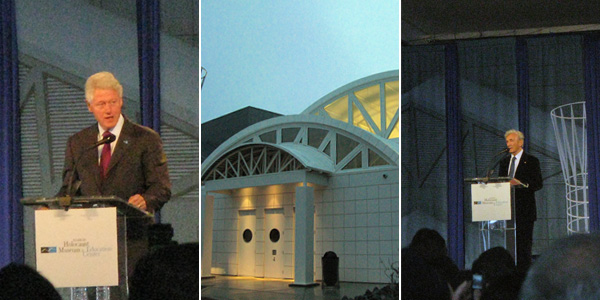Illinois Holocaust Museum Opens
By Benjy Lipsman in Arts & Entertainment on Apr 20, 2009 6:00PM

Photos by Benjy Lipsman
On a damp, chilly afternoon in Skokie, an estimated 12,000 people packed a tent on the grounds of the new Illinois Holocaust Museum & Education Center for the new museum's official opening. The first of its kind in the Midwest, Illinois' Holocaust museum is also likely the last built with the input of Holocaust survivors. The day included performances by hip-hop violinist Miri Ben-Ari and Soul Children of Chicago, as well as speeches from numerous people involved with the creation of the museum, including Holocaust survivor and museum president Samuel R. Harris, Skokie mayor George Van Dusen and Executive Director Richard Hirschhaut. J.B. Pritzker, the museum's capital campaign chairman, served as MC for the afternoon.
The top billing, however, went to two men who have built international reputations for their opposition to genocide. Famed Jewish author, Nobel Prize winner and Holocaust survivor Elie Weisel and former President Bill Clinton spoke about the need to stand up against genocide and how museums like this one can educate future generations about the horrors of the past and how to prevent similar atrocities from happening.
Following the opening ceremonies, the new museum was open for the first public tours. Designed by architect Stanley Tigerman, the 65,000 square foot museum leads visitors from "darnkess to light."
The dark walls and sharp angles represent “the descent into darkness.” The museum exhibits begin in the dark side and shows pre-war Jewish life in Europe, the rise of Hitler and the horrors of the Holocaust. Historical artifacts, posters explaining the history of events and survivor interviews on video make up the bulk of this part of the tour. The second half of the museum “ascends into the light” with soft rounded edges and rooflines filled with natural light emphasize exhibits that represent the rescue and renewal of survivors of the Holocaust. In addition to memorial spaces, there are art galleries that show works representing more recent occurrences of genocide as well as calming reflection room. Joining the two halves is a wedge that includes a period German cattle car used to transport Jews to the concentration camps, and a Book of Remembrance on the upper floor. In the lower level, a children's section will allow schools to bring students to learn lessons and values related to genocide (identity, bullying, cooperation) without subjecting the younger ones to the actual graphic depiction of events seen throughout the rest of the museum.
Blair Kamin's critique of the new museum was published in this weekend's Tribune. We agree with his assessment on the museum's odd orientation toward the expressway. Returning to the grounds last evening to tour the museum for the first time, we were confused about how to approach the entry from the parking lot. While we understand Tigerman's symbolism, this is perhaps one time when the actual site needed to take priority. However, we disagree with Kamin's assessment of museum's exterior itself. We think the clear contrast are both visually interesting and will help children -- one of the primary audiences for a museum -- better understand the symbolism. Meanwhile, inside the museum, more subtle symbolism is at play everywhere to lead visitors through the range of emotions felt when encountering a place explaining such an event.